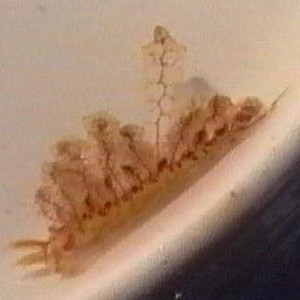
Hermaea bifida
(Montagu, 1815)
Order: SACOGLOSSA
Superfamily: LIMAPONTIOIDEA
Family: Hermaeidae
PHOTO
Zeelandbrug, Oosterschelde, the Netherlands. July 30, 2000. Photo: Peter H. van Bragt.
Thompson describes animal as having a "white body with a rosy blush on the rhinophores and elsewhere on the head, the digestive gland showing through the skin red-brown". The colour tends to fade in unfed animals. There is a conspicuous brownish duct of the digestive gland down each side of the body giving off a branch to each ceras.
Feeds on red algae Griffithsia, Delesseria, and Heterosiphonia. Reported to have a distinctive smell, likened to the Geranium plant and sulphuric acid, by different authors. Grows to about 20mm.
See message below.
References:
• Montagu, G. (1815) An account of some new and rare British shells and animals. Transactions of the Linnean Society of London, 11(2): 179-204.
• Thompson, T.E. (1976) Biology of Opisthobranch Molluscs. Vol 1.. Ray Society: London.
Rudman, W.B., 2000 (August 4) Hermaea bifida (Montagu, 1815). [In] Sea Slug Forum. Australian Museum, Sydney. Available from http://www.seaslugforum.net/find/hermbifi
Related messages
Hermaea bifida - Norway
April 9, 2010
From: Bjørnar Nygård
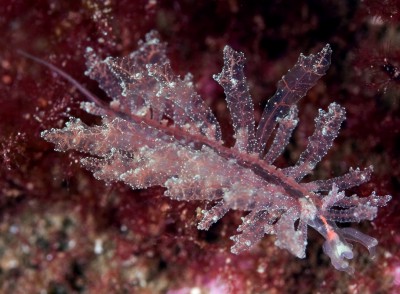
Hi,
I stumbled upon this little beauty of an opisthobranch on Håkjærholmen west of Bergen on the Norwegian west coast on Saturday January 31st 2009. As far as I can tell, it has never been seen in Norway. I turned to Christian Skauge to help me identify it as Hermaea bifida. I later got the ID confirmed by Jussi Evertsen.
Locality: Håkjærholmen, 3.5 meters, Bergen, Norway, North sea, 31.January 2009, Rocky bottom. Length: 50 mm (approx). Photographer: Bjørnar Nygård.
Best regards,
Bjørnar Nygård, Norway
http://www.diverdown.org
bnygard@gmail.com

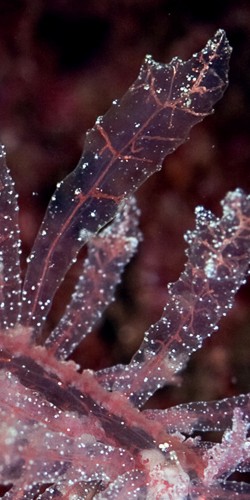
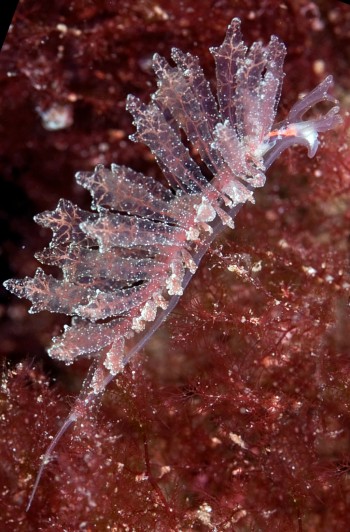
Dear Bjørnar,
Thanks very much for this new record and for the wonderful photos. The animal is so transparent that we can almost examine its anatomy from the outside, without dissection.
Best wishes,
Bill Rudman
Hermaea bifida? from the Scapa Flow
April 24, 2008
From: Stefanie Buell
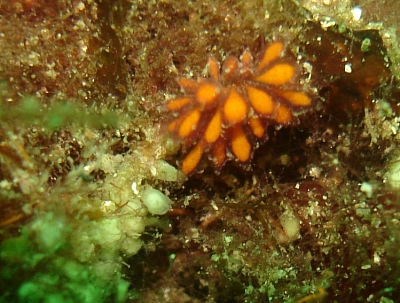
My buddy spotted this fellow; very small (only just managed to get it in focus) with what looked underwater like tiny bright red balloons along it (they look orange in the photos).
Bernard Picton thinks it could be a strange Hermaea bifida, perhaps with the digestive gland full of food. I would be interested to hear what others think.
Locality: Wreckage of MV Mara, Scapa Flow, 14 metres, Orkney, Scotland, UK, North Sea, 14 August 2007, Wreckage of dive boat (!). Length: 5-10 mm. Photographer: Stefanie Buell.
All the best,
Stefanie
stefanie.buell@gmail.com
Buell, S.J., 2008 (Apr 24) Hermaea bifida? from the Scapa Flow. [Message in] Sea Slug Forum. Australian Museum, Sydney. Available from http://www.seaslugforum.net/find/20767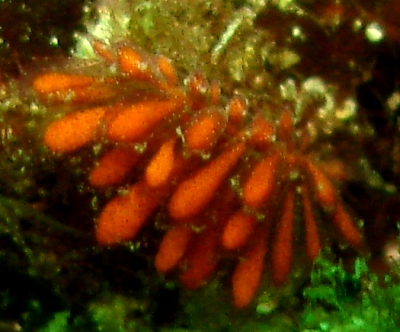
Dear Stefanie,
My first thought must be is it an animal? I can't tell from the two photos if it was actually moving, and if so could it have been something on the back of a crab or a mollusc shell? It looks quite like cephalopod eggs or an algae to me. I can't see any sign of a head or tentacles or anything else which would suggest it is a mollusc, but I could be wrong. Did either you or your buddy see it moving? If not, why do you think its a animal?
Concerning Hermaea bifida, if you look at the photos on the Forum, the digestive gland in that species has a central duct and radiating branches. I can't see how the radial branches would disappear if the central duct became overinflated.
I would be interested in any other comments
Best wishes,
Bill Rudman
Hermaea bifida from the Scottish west coast.
May 26, 2005
From: Jim Anderson
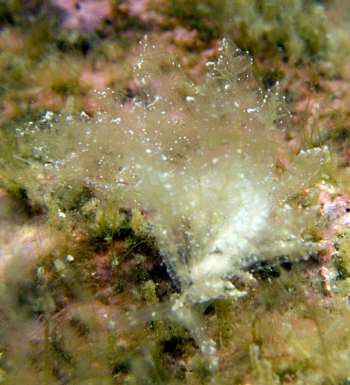
Dear Bill,
Here are some photos of Hermaea bifida. This was a first for me and ID'd by Dr Bernard Picton.
It is very pale in colour and Bernard suggests it had been feeding on a green or brown algae, anyway it was exceptionally well camouflaged. Sea temperature approx 10 deg C.
Locality: Kenmore Point, Loch Fyne, Scotland. Depth: 10 metres. Sea loch on west coast of Scotland. Length: 20 mm (approx). 15 May 2005. boulder slope. Photographer: Jim Anderson
Kind regards,
Jim A
jander4454@gmail.com
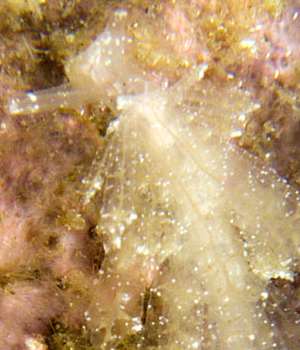
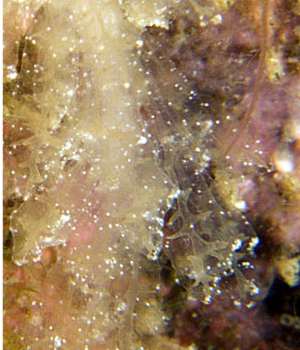
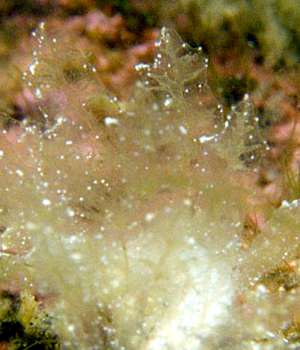
Dear Jim,
Thanks for these photos. It is opportune to have them at the same time as I have been posting photos of a species of Aplysiopsis [see message #13862] as it shows the greatest external difference between the two genera, which is the almost total transparency of species of Hermaea, and the heavy pigmentation found in species of Aplysiopsis.
I have included some close-ups to show the shape of the cerata and the branching of the digestive gland within the cerata.
Best wishes,
Bill Rudman
Hermaea from Mediterranean
May 26, 2001
From: Jean-Pierre Bielecki
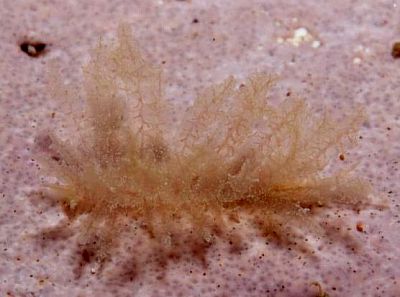
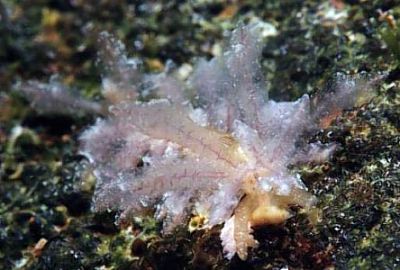
Dear Bill
Here is a new Sacoglossa (for us) found also in Etang de Thau, Sète, South of France. It seems to belong to the Hermaeidae family but we don't know the genus and the species. May be could you help us again to identify it. In fact, we found three different animals at the same place.
Best regards
Jean-Pierre
bielecki.jeanpierre@free.fr
Bielecki, J-P., 2001 (May 26) Hermaea from Mediterranean. [Message in] Sea Slug Forum. Australian Museum, Sydney. Available from http://www.seaslugforum.net/find/4393Dear Jean-Pierre,
I suspect these animals are also Hermaea bifida. In your earlier photos the digestive gland branches in the cerata are much larger, but this is probably an indication of how recently the animals have been feeding. The thin ducts in the photos here suggest that these animals have digested and removed most of the plant material from their digestive gland.
Best wishes,
Bill Rudman
Hermaea bifida from France
February 7, 2001
From: Jean Pierre Bielecki

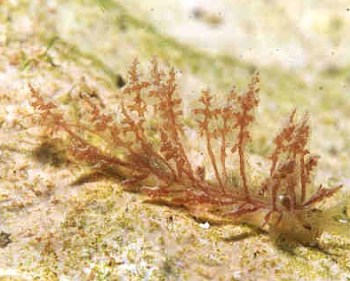
Dear Bill
Thank you for the identification of the blue chromodorid, it is what we were thinking it was. And now I have two other species without identification, please could you help me again?
The first was found in Mediterranean Sea (December 2000, dive site : Etang de Thau, Sète, South of France, Depth 3m, Size 15mm completely mimetic with algae of the same colour).
I will send the second species in a separate message
Best wishes
Jean Pierre Bielecki
bielecki.jeanpierre@free.fr
Bielecki, J.P., 2001 (Feb 7) Hermaea bifida from France. [Message in] Sea Slug Forum. Australian Museum, Sydney. Available from http://www.seaslugforum.net/find/3722Dear Jean Pierre
This is probably Hermaea bifida. If you have a look at Lucas Cervera's earlier message, there is another similar species, H. boucheti which has been described which is differs in having a white patch over the pericardium, just behind the head. I can't see any sign of a white patch in your animal.
Species of Hermaea, as you note are extremely well camouflaged on the algae they live and feed on. The reason their colour is identical is that they take the algal plastids, which contain the plant pigments, and keep them alive in their own bodies.
Best wishes,
Bill Rudman
More photos of Hermaea bifida
September 30, 2000
From: Peter H. van Bragt
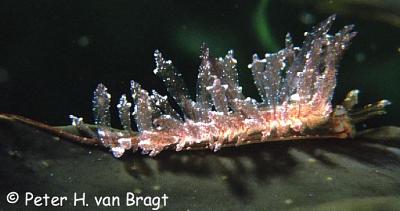
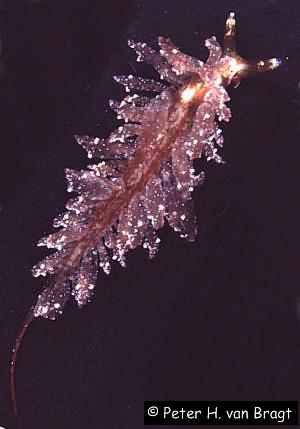
Dear Bill,
Here are some better photos of the Hermaea bifida that has recently been found in the Netherlands:
These specimen were found at "De Zeelandbrug" (Zierikzee), Oosterschelde in August 2000
Best regards
Peter H. van Bragt
vanbragt.phjm@hsbrabant.nl
van Bragt , P.H., 2000 (Sep 30) More photos of Hermaea bifida. [Message in] Sea Slug Forum. Australian Museum, Sydney. Available from http://www.seaslugforum.net/find/3005Thanks Peter,
Bill Rudman.
Re: Hermaea bifida from the Netherlands????
August 25, 2000
From: Juan Lucas Cervera
Dear Bill,
Even if I'm on holidays still, I can check your Forum.
Concerning this "Hermaea bifida" from Holland, in 1991 Ortea, Garcia-Gomez and I, described a new species of Hermaea, H. boucheti, with specimens from NW and SW of the Iberian Peninsula that smelled characteristically once they were collected. Moreover, they had an opaque white cardiacal area. Both features agree with these animals from Netherlands. The description of this species was published in the Iberus journal, in the Proceedings of the VIIth Malacological National Congress of Spain. Unfortunately, I have not available the exact reference, but I will supply you when I return to the University.
I will be very glad if Peter could supply me some specimens of this species.
Regards.
Lucas.
lucas.cervera@uca.es
Cervera, J.L., 2000 (Aug 25) Re: Hermaea bifida from the Netherlands????. [Message in] Sea Slug Forum. Australian Museum, Sydney. Available from http://www.seaslugforum.net/find/2909Dear Lucas,
I just found the reference:
• Cervera, J.L., Garcia-Gomez, J.C & Ortea, J.A. (1988) A new species of the genus Hermaea (Gastropoda: Opisthobranchia: Sacoglossa) and redescription of two rare sacoglossans of the European malacofauna. Iberus, 8(2): 215 - 224.
I will follow the discussion on whether there is one species or two with interest.
Best wishes,
Bill Rudman.
Re: new species for the Netherlands????
August 9, 2000
From: Peter H. van Bragt
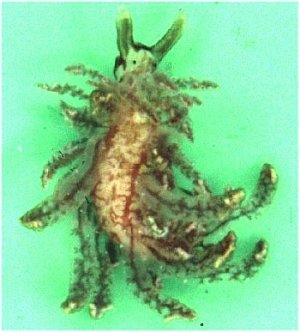
Hallo Bill and Lucas,
The determination has been confirmed by Bernard Picton and Rob Dekker. It is indeed Hermaea bifida. I have attached some more pictures of this particular individual. After it was collected it produced a very typical smell. I would describe it as being very strong, unpleasant and acidic. First I thought that the smell came from the plastic food container, in which it was brought to me, and due to possibly remaining food smells. But know I understand that H. bifida can produce this extrme and unpleasant smell. The specimen on the videograph was found on July 30, 2000 at the Zeelandbrug, Oosterschelde, the Netherlands.
The enclosed pictures are from this specimen, which is the same as the one on the videograph that was send earlier.
Today I received a message from some other divers with photographic proof that at the same location two days earlier the same species was found. It is not clear if it is the same animal or if more indivuduals are present. If I get permission from the person who made these pictures I will send them to you as well.
The last couple of years we have found new or rare species of nudibranchs in Dutch coastal waters, and in most cases more than one individual was spotted.
With greetings from the Netherlands,
Peter H. van Bragt
vanbragt.phjm@hsbrabant.nl
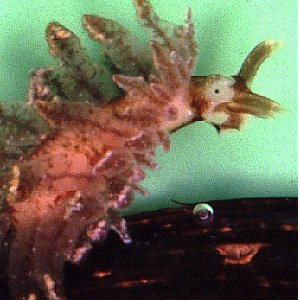
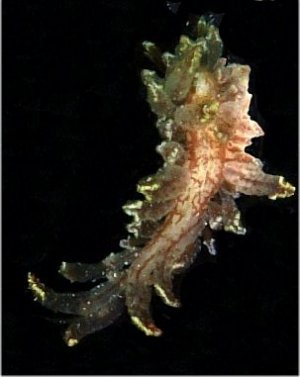
Dear Peter,
I am always a bit hesitant about attempting to identify Atlantic species, so I am glad I didn't lead you astray. Not that it will make me any more confident in trying to identify large flat dorids however.
You can clearly see the enrolled rhinophores anf the branching digestive gland duct in the cerata. I am intrigued by the acid smell. Does anyone know if the chemistry of the secretion has been studied? I seems like it might be an interesting story.
Best wishes,
Bill Rudman.
Re: A new species for the Netherlands????
August 6, 2000
From: Juan Lucas Cervera
Hi Bill,
Concerning your identification. I'm in agreement with you absolutely.
Regards.
Lucas.
lucas.cervera@uca.es
Cervera, J.L., 2000 (Aug 6) Re: A new species for the Netherlands???? . [Message in] Sea Slug Forum. Australian Museum, Sydney. Available from http://www.seaslugforum.net/find/2845A new species for the Netherlands????
August 5, 2000
From: Peter H. van Bragt

Dear Bill
Yesterday we have found, what we believe is a new species of Nudi for the Netherlands (number 46, our nudi list is still not so very big). I have enclosed a digital image from a video recording. The quality is not so good but I am working on slides that should be available by the end of this week.
I believe it is a Eubranchus species. It is not likely to be of any help, but at the moment I only have the following information:
It was found on a species of seaweed.
At approx. 5 meters depth.
It is approx. 12 mm in length.
This message was also send to Michael Miller and other nudi experts. So far we have no idea what it is! Can you help???
I am still working on completing the Dutch list for the Forum. But I can find little time to do so. Perhaps I am just diving too much. Sorry for the delay.
With best regards
Peter H. van Bragt
vanbragt.phjm@hsbrabant.nl
Dear Peter,
I think this is probably a sacoglossan rather than a nudibranch. There only seem to be one set of obvious head tentacles, and they seem to be enrolled. At a guess I would say it is probably Hermaea bifida (Montagu, 1815), which is usually found on red algae. According to various authors (see Thompson, 1976) it has a strange smell likened to a Geranium plant, and sulphuric acid.
But perhaps I should wait until you can send some slides.
Best wishes,
Bill Rudman.
